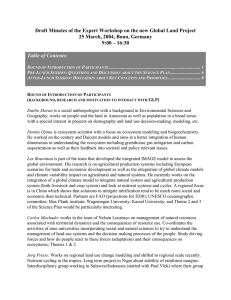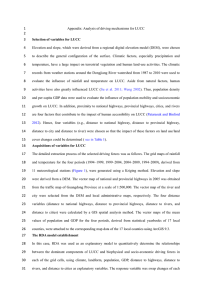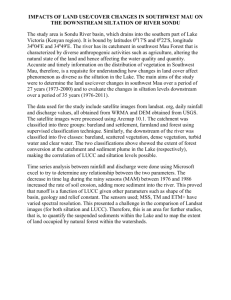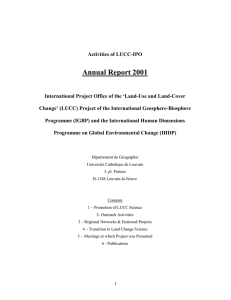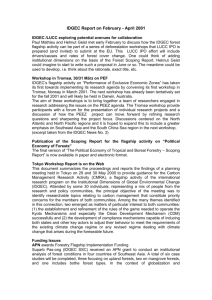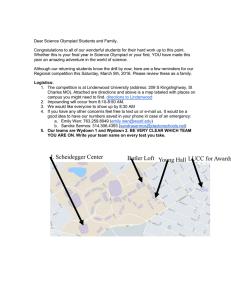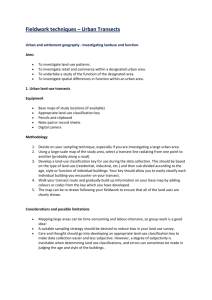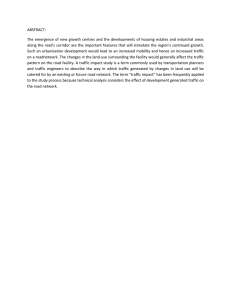LUCC Report 2002 Land-Use and Land-Cover Change (LUCC) Project 1
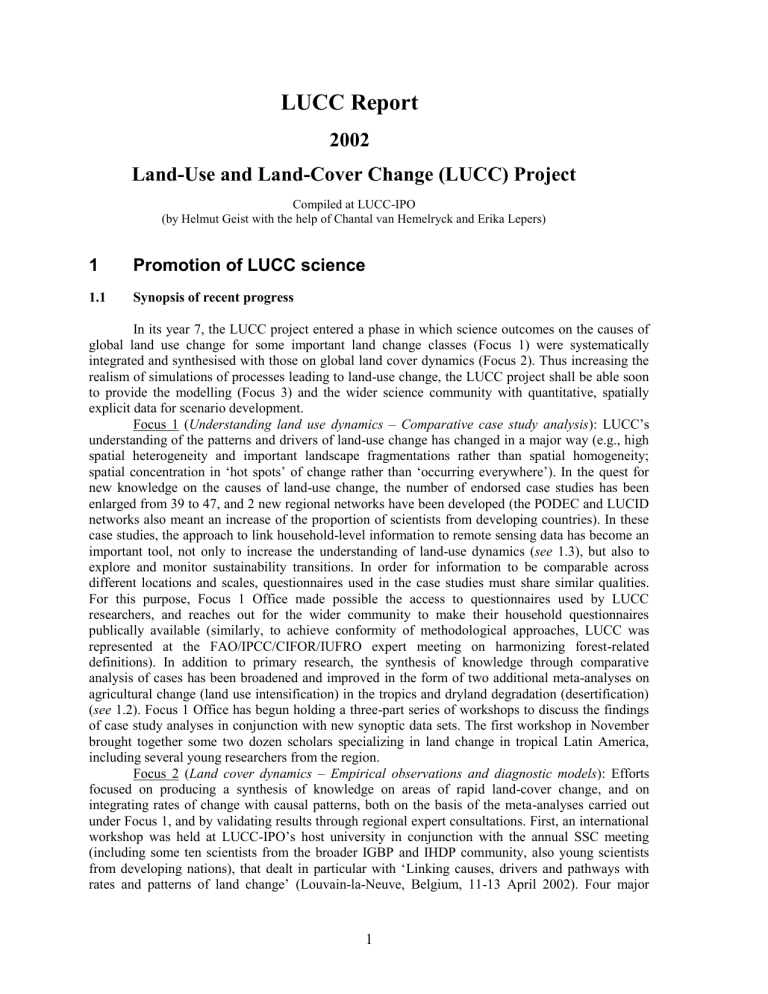
LUCC Report
2002
Land-Use and Land-Cover Change (LUCC) Project
Compiled at LUCC-IPO
(by Helmut Geist with the help of Chantal van Hemelryck and Erika Lepers)
1 Promotion of LUCC science
1.1
Synopsis of recent progress
In its year 7, the LUCC project entered a phase in which science outcomes on the causes of global land use change for some important land change classes (Focus 1) were systematically integrated and synthesised with those on global land cover dynamics (Focus 2). Thus increasing the realism of simulations of processes leading to land-use change, the LUCC project shall be able soon to provide the modelling (Focus 3) and the wider science community with quantitative, spatially explicit data for scenario development.
Focus 1 ( Understanding land use dynamics – Comparative case study analysis
): LUCC’s understanding of the patterns and drivers of land-use change has changed in a major way (e.g., high spatial heterogeneity and important landscape fragmentations rather than spatial homogeneity; spatial concentration in ‘hot spots’ of change rather than ‘occurring everywhere’). In the quest for new knowledge on the causes of land-use change, the number of endorsed case studies has been enlarged from 39 to 47, and 2 new regional networks have been developed (the PODEC and LUCID networks also meant an increase of the proportion of scientists from developing countries). In these case studies, the approach to link household-level information to remote sensing data has become an important tool, not only to increase the understanding of land-use dynamics ( see 1.3), but also to explore and monitor sustainability transitions. In order for information to be comparable across different locations and scales, questionnaires used in the case studies must share similar qualities.
For this purpose, Focus 1 Office made possible the access to questionnaires used by LUCC researchers, and reaches out for the wider community to make their household questionnaires publically available (similarly, to achieve conformity of methodological approaches, LUCC was represented at the FAO/IPCC/CIFOR/IUFRO expert meeting on harmonizing forest-related definitions). In addition to primary research, the synthesis of knowledge through comparative analysis of cases has been broadened and improved in the form of two additional meta-analyses on agricultural change (land use intensification) in the tropics and dryland degradation (desertification)
( see 1.2). Focus 1 Office has begun holding a three-part series of workshops to discuss the findings of case study analyses in conjunction with new synoptic data sets. The first workshop in November brought together some two dozen scholars specializing in land change in tropical Latin America, including several young researchers from the region.
Focus 2 ( Land cover dynamics – Empirical observations and diagnostic models ): Efforts focused on producing a synthesis of knowledge on areas of rapid land-cover change, and on integrating rates of change with causal patterns, both on the basis of the meta-analyses carried out under Focus 1, and by validating results through regional expert consultations. First, an international workshop was held at LUCC-IPO’s host university in conjunction with the annual SSC meeting
(including some ten scientists from the broader IGBP and IHDP community, also young scientists from developing nations), that dealt in particular with ‘Linking causes, drivers and pathways with rates and patterns of land change’ (Louvain-la-Neuve, Belgium, 11-13 April 2002). Four major
1
classes of land change were explored, being of value, too, for the LAND project: (i) conversion, degradation and fragmentation of tropical forests, (ii) land degradation and desertification, (iii) fire and other ecosystem disturbances, and (iv) land use intensification, including the rural-urban fringe.
Second, an international regional expert and validation workshop was held to assess areas undergoing rapid land/cover change during the past 15 to 20 years (Washington, D.C., USA, 24-26
November 2002), together with GOFC/GOLD and meant as input into the work of Millenium
Ecosystem Assessment ( see 1.2). In addition, issue no. 8 of the LUCC Newsletter (December 2002) was designed to be a special issue on new global-scale datasets on land-cover change. The issue presents the work of a number of LUCC-endorsed or otherwise LUCC-related teams that have started, after several years of methodological research on monitoring techniques and environmental indicators, to produce datasets on a range of land change processes. Their works typically merge remote sensing information with fine scale statistical data or expert opinion, such as the LUCCendorsed TREES project (with a publication in Science , 2002). Furthermore, gaps and priority issues could be identified which relate to the difficult-to-measure land cover modifications (e.g., forest and dryland degradation, land use intensification), with detailed regional studies at best providing the level of information required. In May, LUCC was represented at an FAO/UNEP consultation on strategies for global land cover mapping and monitoring.
Focus 3 ( regional and global integrated models ): The modelling of land-use change made great strides with the application of new technologies, for example, in the field of agent-based modelling and cellular automata. As a major step, the agent-based modelling framework got incorporated into the study of land-use change and land-cover change processes. An approved breakout session during a NAS colloquium on agent-based modelling in Irvine, CA (October 2001) lead to LUCC Report #6 (2002) and a primary science publication ( see 1.3). In addition, Focus 1
Office administers the ‘M(ulti)A(gent)Space Listserv’ which was created as a forum for discussion, and which currently has some 200 subscribers. The listserv initiative complements the major effort of LUCC-IPO to sharpen and harmonize the training of the next generation of land change researchers in modelling: 17 teachers had been training more than 40 post-graduate students from all over Europe in the MODLUC ‘Advanced Study Course’ (Modelling Land Use Change) at IPO’s host university (27 October – 2 November 2002) ( see 3.3). Following the SSC Meeting and workshop in April, the concept of land-use transition is being developed to support scenario development. The workshop suggested that the concept offers an integrative framework to link a set of theories and models of particular components of the land-use system, thereby allowing a detailed examination of the dependence of drivers of land-use change on the specific land use history of a location. By linking causes, drivers and pathways of land-use change with rates and patterns of landcover change, the concept provides a better empirical foundation to predict future or alternative trajectories of land change. A joint paper was drafted and circulated in June, with the intention to contribute to the identification of gaps and prioritisation of LUCC as well as LAND research.
1.2
Science Highlights
[ a ] Meta-analyses of the causes of land-use change: The quest for new knowledge on the causes of land-use change through comparative analysis of cases was speeded up by means of two major meta-analyses, i.e. statistical techniques to synthesize results from individual studies.
Following a first meta-analysis (N=152 cases) of the causative pattern behind tropical forest losses – published in BioScience in 2002 -, a comparative study of cases of desertification (N=132) generated results on causes, drivers, rates and indicators of dryland degradation. The causative factor analysis included proximate causes, underlying driving forces, mediating factors, and properties of systems dynamics such as feedbacks and thresholds. Rates of dryland change were standardized on an annual percentage basis to allow for comparison between cases and to hold apart slow from fast variables of change. Complementing LUCC-IPO’s efforts regarding tropical deforestation and desertification,
Focus 1 Office at Indiana University, Bloomington (USA), has spent the majority of the past year on
2
a comparative examination of cases studies of agricultural change in the tropics (N=143). Dr. Eric
Keys was hired as postdoctoral fellow from January to July to assist in the effort of coding some four dozen variables and analysing data in terms of both outcomes (e.g., intensification) and identification of the biophysical and socio-cultural factors associated with the various outcomes. As for both metaanalyses, results are currently (ie. December) written up, with publication strategies already set up.
[ b ] Global synthesis of the areas of rapid land-cover change: In February, A synthesis of knowledge of rapid land-cover and land-use change (a joint LUCC and GOFC/GOLD project for the
Millennium Ecosystem Assessment) was started, with major work done at LUCC-IPO. The project maps, at a global scale, areas which have experienced rapid land-cover change during the last fifteen to twenty years. The exercise, based on existing databases, helps to focus attention on ‘hot spots’ of land-cover changes and to identify change processes for which poor information and data are available. Within one year’s time, a synthesis shall be achieved of all previous works on the subject
(e.g., deforestation, intensification, soil degradation, desertification, urban expansion, exceptional fires). In the final product, the areas affected by significant land-cover change will be outlined on top of the new GLC 2000 global land cover map. Different thematic codes will be used for different processes of change. For each change patch, a description of the nature of the change, date, causes, impacts, detection method and references will be included. In June, all existing data were compiled, and all information brought into a common format. Draft results were made available in the internet and as CD-ROM for review and comment. Following internet consultation, an international validation workshop bringing together representatives of all the major regions of the world has been held in Washington, D.C. (November 24-26). The initial map got validated and refined, and the areas of change which have been detected were documented. Moreover, the maps have been compared with finer-scale datasets (Landsat-based change maps and published case studies of deforestation). In the next few months, the maps will be improved by adding new census datasets and regional remote sensing-derived data, especially for the northern latitude. The product will be finished in September
2003, at latest.
1.3
List of publications
Publications only that were released from press or submitted/accepted in 2002, that result from
LUCC value-adding (incl. joint GCTE-LUCC) activities, which cite the Research Plan and/or Implementation
Strategy, or which are explicitly identifiable as products of LUCC, IHDP or IGBP (i.e., logo, project name in introduction or acknowledgements or footnotes). No newsletter articles.
BOOKS:
[ 1 ] Fox, J., Rindfuss, R.R., Walsh, S.J., Mishra, V. (eds) (2002) People and the environment:
Approaches for linking household and community surveys to remote sensing and GIS. Kluwer Academic
Publishers: Boston, Dordrecht, 344 pp.
[ 2 ] Reynolds, J., Stafford Smith, M. (eds) (2002) Global desertification: Do humans create deserts? (=
Dahlem Workshop Report #88). Dahlem University Press: Berlin, 438 pp.
[ 3 ] Abrol, Y.P., Sangwan, S., Tiwari, M.K. (eds) (2002) Land use: Historical perspectives. Focus on
Indo-Gangetic Plains. Allied Publishers: New Delhi, 667 pp.
[ 4 ] Turner, B.L. II, Geoghegan, J., Foster, D.R. (eds) (2003) Integrated land-change science and tropical deforestation in the southern Yucatán: Final frontiers. Oxford University Press: Oxford. 416 pp., in press .
[ 5 ] Lepers, E., Lambin, E.F., Janetos, T., DeFries R. et al. (2003) Areas of rapid land-cover change of the world. MEA Report. Millenium Ecosystem Assessment: Penang, Malaysia, submitted .
[ 6 ] Leemans, R., Lambin, E.F., McCalla, A., Nelson, J., Watson, B., Zurek, M. (2003) Drivers that determine changes in ecosystems and ecosystems services. Conceptual Framework Report. Millenium
Ecosystem Assessment: Penenang, Malaysia, submitted .
SYNTHESIS PAPERS:
3
[ 1 ] Geist, H.J. and Lambin, E.F. (2002) Proximate causes and underlying driving forces of tropical deforestation. BioSience . Vol. 52 (2): 143-150.
[ 2 ] Turner, B.L. II (2002) Toward integrated land-change science: Advances in 1.5 decades of sustained international research on land-use and land-cover change. In: Steffen, W., Jäger, J., Carson, D.J. and
Bradshaw, C. (eds) Challenges of a Changing Earth. Proceedings of the Global Change Open Science
Conference, Amsterdam, The Netherlands, 10-13 July 2001. Springer: Berlin, et al., pp. 21-26.
[ 3 ] Ramankutty, N., Foley, J.A. and Olejniczak, N.J. (2002) People on the land: Changes in global population and croplands during the 20th century. Ambio . Vol. 31(3): 251-257.
[ 4 ] Moran, E.F. (2003) Progress in the Last Ten Years in the Study of Land Use/Cover change and the
Outlook for the Next Decade. In: Diekmann, A., Dietz, T., Jaeger, C.C. and Rosa, E.A. (eds) Studying the
Human Dimensions of Global Environmental Change. MIT Press: Cambridge, MA, in press .
[ 5 ] Parker, D.C., Manson, S.M., Janssen, M.A., Hoffmann, M.J. and Deadman, P. (2003) Multi-Agent
System Models for the Simulation of Land-Use and Land-Cover Change: A Review. – Annals of the
Association of American Geographers . Vol. 93 (2), in press .
[ 6 ] Klein Goldewijk, K. and Ramankutty, N. (2003) Land Cover Change over the Last Three
Centuries Due to Human Activities: Assessing the Differences Between Two New Global Data Sets.
GeoJournal , in press .
[ 7 ] Lambin, E.F. and Geist, H.J. (2003) The land managers who have lost control of their land use –
Implications for Sustainability. Journal of Tropical Ecology . Vol. 19, accepted .
[ 8 ] McConnell, W. and Keys, E. (2003) Lessons from the Comparative Analysis of Agricultural
Change in the Tropics. In: Moran, E. (ed) Seeing the Forest and the Trees: Human-Environment Interactions in
Forest Ecosystems. CIPEC: Bloomington, Indiana, accepted .
[ 9 ] Lambin, E.F., Geist, H.J., and Lepers, E. (2003) Dynamics of land-use and land-cover change in
Tropical Regions. – Annual Review of Environment and Resources . Vol. 28, submitted .
LUCC REPORT SERIES
Parker, D.C., Berger, T. and Manson, S.M. (eds) (2002) Agent-based models of land-use and landcover change. Report and Review of an International Workshop, October 4-7, 2001, Irvine, California, USA (=
LUCC Report Series No. 6). LUCC Focus 1 Office: Bloomington, Indiana.
JOURNAL ARTICLES:
[ 1 ] Bucini, G. and Lambin, E.F. (2002) Fire impacts on vegetation in Central Africa: A remote sensing-based statistical analysis. – Applied Geography . 22 (1), 27-48.
[ 2 ] Kok, K. and Winograd, M. (2002) Modelling land-use change for Central America, with special reference to the impact of hurricane Mitch. – Ecological Modelling , 149(1/2), 53-69.
[ 3 ] Petit, C. and Lambin, E.F. (2002) Long-term land-cover changes in the Belgian Ardennes (1775-
1929): Model-based reconstruction versus historical maps. – Global Change Biology . Vol. 8(7), 616-22.
[ 4 ] Wang, S.Q., Xu, J., Zhou, C.H., He, C.F. (2002) Using remote sensing to estimate the change of carbon storage: a case study in the estuary of Yellow River delta. – International Journal of Remote Sensing .
Vol. 23(8), 1565-1580.
[ 5 ] McConnell, W. (2002) Misconstrued land use in Vohibazaha: Participatory planning in the periphery of Madagascar's Mantadia National Park. – Land Use Policy . Vol. 19(3): 217-230.
[ 6 ] Aspinall, R. (2002) A land-cover data infrastructure for measurement, modeling, and analysis of land-cover change dynamics. – Photogrammetric Engineering & Remote Sensing . Vol. 68(10), 1101-1105.
[ 7 ] Biggs, R., Scholes, R.J. (2002) Land cover changes in South Africa 1911-93. – South African
Journal of Science. Vol. 98, 420-428.
[ 8 ] DeFries, R.S., Houghton, R.A., Hansen, M.C., Field, C.B., Skole, D., Townshend, J. (2002)
Carbon emissions from tropical deforestation and regrowth based on satellite observations for the 1980s and
1990s. – Proceedings of the National Academy of Sciences of the United States of America . Vol. 99, 14256-
14261.
[ 9 ] Moran, E.F., and Evans, T.P. (2003) Spatial integration of social, political and biophysical factors contributing to land cover change. – Population and Development Review , in press.
[ 10 ] Brondizio, E., Castro, F. de, Forsberg, M. and Moran, E.F. (2003): The Use of remotely-sensed data in rapid rural assessment. – Field Methods , in press .
4
[ 11 ] Lu, D., Mausel, P., Moran, E.F. and Brondizio, E. (2003) Comparison and classification of secondary succession forests in the Brazilian Amazon Basin. – International Journal of Remote Sensing , in press .
[ 12 ] Taylor, C., Lambin, E.F., Stephenne, N., Harding, R. and Essery, R. (2003) The influence of land-use change on climate in the Sahel. Journal of Climate , in press.
BOOK CHAPTERS:
[ 1 ] Moran, E.F., Brondizio, E.S., McCracken, S.D. (2002): Trajectories of land use: Soils, succession, and crop choice. In: Wood, C.H. and Porro, R. (eds) Patterns and processes of land use and forest change in the
Amazon. University of Florida Press: Gainesville, 193-217.
[ 2 ] Fox, J. (2002) Understanding a dynamic landscape: Land use, land cover and resource tenure in
Northeastern Cambodia. In: Walsh, S.J. and Crews-Meyer, K.A. (eds) Linking people, place, and policy: A
GIScience approach. Kluwer Academic Publishers: Boston, 113-130.
[ 3 ] Deng, X., Liu, J., Liu, M., Xu, X., Zhan, J., and Zhao, T. (2002) Land-use change and dynamics for the ecotone between agriculture and pasturing in Northern China, 1990-2000. In: Himiyama, Y. (ed) China-
Japan Comparative Study of Land Use/Cover Changes (part I). Hokkaido University: Asahikawa, 61-74.
[ 4 ] Rindfuss, R.R., Entwisle, B., Walsh, S.J., Prasartkul, P., Sawangdee, Y., Crawford, T.W., Reade,
J. (2002) Continuous and discrete: Where they have met in Nang Rong, Thailand. In: Walsh, S.J. and Crews-
Meyer, K.A. (eds) Linking people, pPlace, and policy: A GIScience approach. Kluwer Academic Publishers:
Boston, 7-37.
[ 5 ] Veldkamp, T., Verburg, P.H., Kok, K., Koning, F.D., Soepboer, W. (2002) Spatial explicit land use change scenarios for policy purposes: Some applications of the CLUE framework. In: Walsh, S.J. and
Crews-Meyer, K.A. (eds) Linking people, place, and policy: A GIScience approach. Kluwer Academic
Publishers: Boston, 317-341.
[ 6 ] Moran, E., Ostrom, E. and Randolph, C. (2003) Ecological Systems and Multitier Human
Organizations. In: UNESCO/Encyclopedia of Life Support Systems. Oxford, UK: EOLSS Publishers, in press .
[ 7 ] Geist, H.J. (2003) The Land-Use and Cover Change (LUCC) project. In: UNESCO/Encyclopedia of Life Support Systems. Oxford, UK: EOLSS Publishers, in press .
[ 8 ] Moran, E.F. (2003) The Challenge of Scalability. In: Redman, C. and Zisner, C. (eds) The
Archeology of Global Change. Smithsonian Institution Press: Washington, DC, in press .
[ 9 ] Lim, K., Moran, E.F., Deadman, E., Brondizio, S. and McCracken, S.D. (2003): Agent-based simulations of household decision making and land use change in Altamira, Brazil. In: Integrating geographic information systems and agent-based modeling techniques for understanding social and ecological processes.
Oxford University Press: Oxford, in press .
2 Projected main activities to the conclusion of LUCC
The further development of the synthesis of LUCC research will be of overriding importance, especially integrating Foucs 1 and 2 research results into modelling. The following implementation tools and/or activities are projected, or already in operation:
[ a ] Two more meta-analyses will be designed under Focus 1, in order to have comparative case study information in 2003 to 2005: first, on the rates and causes of urban land cover change
(Focus 1 Office or IPO), and, second, on the vulnerability of people and ecosystems to land usedriven environmental change. The The latter will be done as post-doctoral research at the School of
Geography, Archaeology and Environmental Studies of the University of the Witwatersrand,
Johannesburg (James Smith/C. Vogel).
[ b ] Focus 1 Office will continue holding a three-part series of regional validation workshops in 2003 (Sub-Saharan Africa, South/Southeast Asia), thus contributing to the LUCC synthesis through publication of results in the LUCC Report Series
[ c ] The global assessment of areas undergoing rapid land-cover change ( see 1.2) will be complemented by an evaluation of regional datasets. A primary science publication in a peerreviewed, international journal will be completed in September 2003, at latest.
5
[ d ] The NASA Land Cover Land Use Change (LCLUC) program and the LUCC project, in collaboration with various partners, start an annual international colloquium series on land change issues, with particular emphasis on remote sensing (RS) and GIS capabilities focussing on the interactions between humans and ecosystems. While the initiative is primarily meant to establish closer links between NASA research components and IGBP/IHDP, it also helps (i) to deepen and further advance the understanding coming from RS-based LUCC case studies, and (ii) to fill gaps in recently identified land-cover modification studies (such as desertification).
[ e ] The series of workshops at the 3 rd IGBP Congress in Banff, Canada (19-24 June 2003) is mainly used to push development of research within the LAND project under IGBP II. For this purpose, the following workshops, jointly done with other IGBP core projects or ESSP members, were proposed in September: dryland degradation (GCTE, ARIDNET), biodiversity
(DIVERSITAS), fire regimes (GCTE), and land use effects in coastal zones, or along the water continuum (LOICZ II).
[ f ] In the course of preparing the next Open Meeting of the Human Dimensions of Global
Environmental Change Research Community in Montreal, Canada (‘Taking stock and moving forward’, 16-18 October 2003), it is currently (ie. December) explored how the proposed session on land-use and land-cover change (O. Coomes) can be best used as an another platform for promoting
LUCC synthesis.
[ g ] For the purpose of integrating the synthesis of results from meta-analyses on causes of land-use change with rates of land-use and land-cover change into modelling, a focussed workshop on modelling synthesis is planned to be organized by the new Focus 3 Office at Wageningen
University in 2004/2005 (T. Veldkamp). Nine sessions on land-use change modelling at the LUCCendorsed conference ‘Framing Land Use Dynamics’ (Utrecht, 16-16 April 2003) will lay ground for this (T. Veldkamp).
[ h ] As a further step in modelling, additional efforts will be started for a new generation of regional and global land-use change scenarios. This will mainly include integration of the IPO ‘MA project’ databases for modelling ‘hot spots’ of land-use change, given the premises of various development scenarios (e.g., climate change, globalization) and modelling work carried out under the newly established Focus 3 and by newly appointed SSC members (J. Alcamo).
[ i ] In addition, preparatory workshops will be organised by the Focus 3 Office in collaboration with the Focus 1 (‘people and pixels in modelling’, agent-based modelling, integration of spatial models) anmd Focus 2 Offices (spatial autocorrelation, CA/neighborhood interactions, spatial scaling techniques for remote sensing and socio-economic data).
[ j ] The development of the concept of land-use transitions as an integrative framework will be continued so as to support empirically informed scenario development, with a primary science publication to be completed in 2003. Negotiations were started with several partners outside of the
LUCC network to run a validation workshop or LUCC-endorsed conference on the theme in late
2003.
[ k ] MODLUC course materials ( see 3.3) have progressively been extended to other users via website information, in particular to post-graduate scientists in LDC and FSU/EE countries.
3 Outreach Activities and Collaborations
3.1 Regional [R] and focused [F] workshops
In the period considered, 5 regional workshops and 3 focused workshops were organised (or assisted in organisation) and/or major inputs provided:
[ F ] LUCC workshop ‘Linking household and remotely sensed data: Methodological and practical problems’, 3-8 January 2002, East-West Center, Honolulu, Hawaii,.USA.
6
[ R ] 3 rd Workshop on ‘Land use/change management and trace gas emission in East Asia’, 8-10 January
2002, Los Baños, Philippines.
[ F ] LUCC International Workshop ‘Linking causes, drivers and pathways with rates and patterns of land change’, 11-13 April 2002, Louvain-la-Neuve, Belgium (in conjunction with annual SSC meeting).
[ R
] APN synthesis Workshop on ‘Land Use and Cover Change in Asia-Pacific Region’, 9-11 September
2002, Kobe, Japan.
[ R ] LUCC Focus 1 Workshop ‘Land Change in Latin America’, 16-19 November 2002, Center for
Environmental Studies, Arizona State University, Tempe, USA.
[ F ] ‘A synthesis of knowledge: Rapid land-cover and land-use change’, International LUCC-
GOFC/GOLD Workshop for Millenium Ecosystem Assessment and NASA, Westinn Embassy Row,
Washington, D.C., 24-26 November 2002.
[ R ] LUCC Focus 2 workshop on ‘Asian Environmental Problems’, 2 December 2002, Hyderabad, India.
[ R ] Advanced START-SARCS training workshop on ‘Land use and land cover change study’, 8-20
December 2002, Taipei, Taiwan.
3.2
Diffusion of newsletter, web site information, reports and others
[ a ] In October to November, LUCC newsletter No. 8 was produced, and sent out in
December. This implied a major database revision (update), with the number of entries, i.e., newsletter users, being reduced from ca. 2,400 to ca. 1,500. The newsletter is a ‘special issue’ on patterns and rates of land cover change with invited contributions from major research groups or consortiums. Core topics of the Newsletter are the synthesis of knowledge on rapid land-cover and land-use change (LUCC-IPO), the GLC 2000 map (JRC), the TREES project (JRC), the AVHRR-
8km Land Pathfinder data on deforestation (University of Maryland), the Night-time light change product (NOAA), the GBA 2000 dataset (JRC) and the LADA project (FAO).
[ b ] Web site information (http://www.geo.ucl.ac.be/LUCC), especially calendar, research and publication information, was constantly updated.
[ c ] Annual and bi-annual project reports and email updates were sent out regularly to the
IGBP and IHDP secretariats (January, December), to the Belgian Federal Office for Science,
Technology and Cultural Affairs (OSTC) (January, June and December), and to the SSC via the
LUCC email exploder (January, July).
[ d ] In the period considered, LUCC-IPO organised the review process for the proposed
LUCC Reports #6 (agent-based modelling) and #7 (outcomes of the 2001 LUCC Tokyo symposium), with Report #6 published by Focus 1 Office in November.
[ e ] In March to May, final comment and work was done on the web-based land use thematic guide of CIESIN (available online for beta-testing in July, and released in August): http://sedac.ciesin.columbia.edu/tg/guide_main.jsp.
3.3
Training & other outreach activities
[ a ] With support from the European Commission, DG XII Environment and Climate
Programme, LUCC-IPO organised an Advanced Study Course ‘Modelling Land Use Change’
(MODLUC) at the University of Louvain, Louvain-la-Neuve, Belgium, from 27 October 2002 until
2 November 2002. MODLUC brought together more than 40 post-graduate students from all over
Europe and about 17 key lecturers for training in modelling techniques within the context of global environmental change research. MODLUC provided a state-of-the-art synthesis of land-use change modelling as part of environmental modelling in the domain of global change research, covering five broad types of models: (i) empirical-statistical & GIS based models / transition probability models,
(ii) optimisation models / linear programming, (iii) dynamic simulation models, (iv) agent-based models & cellular automata, and (v) hybrid/integrated models. The course allowed students to evaluate the strengths and limitations of the different model types, to assess their explanatory and predictive powers and thus their applicability to specific problems of global change. Course
7
materials such as downloadable tools, data, documents and teaching materials are still kept available at LUCC’s website (‘MODLUC’).
[ b ] In July, LUCC-IPO negotiated with Kluwer Academic Publishers and Dahlem University
Press buying up a certain amount of Reynolds & Stafford-Smith (2002) and Fox et al. (2002) for distribution among LUCC members in developing countries ( see 1.3), in order to lower the unit price of books for distribution among LUCC network members in LDC and FSU/EE countries.
[ c ] In the period considered, LUCC-IPO – alone or together with host department – had six visitors: H. Wiggering and K. Helming (Center of Agricultural Landscape Research, Germany), A.G.
Sanchez-Azofeifa and P. Van Laake (Unversity of Alberta, Canada), Tom Veldkamp (Agricultural
University of Wageningen, The Netherlands), and E. Milne (The University of Reading, Great
Britain).
[ d ] In the period considered, some 140 requests were received by LUCC-IPO concerning information material, publications, project involvement, etc., which were proceeded adequately.
3.4 Dialogue with funding agencies
InterAmerican Institute (ISI) : distribution of small grant programme announcement to LUCC endorsed projects (at least one project applied).
European Commission (EC), Research Directorate General : expression of interest to the 2002 exercise under FP6 (‘network of excellence’), mainly.
Belgian Federal Office for Scientific, Technical and Cultural Affairs (OSTC) : data generation on the involvment of Belgian research units in IHDP, IGBP and START programme activities; submission of proposal for continuation of IPO support beyond February 2003.
Global Change System for Analysis, Research and Training (START) & Pan African START
Secretariat (PASS) : review of proposals for fellowship awards; co-development of a proposal for a regional network in Central Asia; interaction with West African regional network.
U.S. National Science Foundation (NSF) : generation of names for a proposed network on land degradation research for Europe/Africa (ARIDNet).
NASA’s Land Use and Land Cover Change (LCLUC) Programme
: recruitment of (at least 3)
LUCC reviewers for LBA/NASA activities.
Slovak Academy of Sciences : review of a proposal to establish a LUCC center of excellence.
3.5 Collaborations
[ a ] As for the further development of the LAND compartment under IGBP II, in the period considered the following actions were taken:
LUCC continued to be represented in the LAND transition team (TT) with two co-chairs (E. Moran, L.
Graumlich) and five nominated reseachers (O. Coomes, N. Ramankutty, B. Turner, K. Rajan, A. Pfaff), totaling one third of the LAND TT. There had been three LAND-related meetings in Fort Collins, USA
(January), Bilthoven, The Netherlands (October), and Paris, France (October), with the latter developing collaborations between LAND and the land-atmosphere interface project (ILEAPS). These meetings were meant to work out researchable science questions and draft the LAND science plan. In November, the
IGBP secretariat expressed special thanks to LUCC’s TT members for their valuable work.
At its annual meeting in Louvain-la-Neuve, Belgium (April 11-13), held in conjunction with an international workshop, the LUCC-SSC expressed its support for the further development of the concept of a LAND project and encouraged the co-chairs from LUCC to continue with their work. Two newly appointed SSC members (O. Coomes, N. Ramankutty) were given as an additional responsibility to provide input into the LAND agenda.
At its annual meeting in Louvain-la-Neuve, E. Moran provided an overview on the scientific aspects of the project (objectives, 3 overarching questions, place-based, historically informed, land centric, integrative, etc.), which opened lots of interest, started a lively discussion and lead to some recommendations as laid
8
down in the minutes (April). Updates on the three joint and integrative GCTE-LUCC project activities were given by S. Lavorel (fire, landscape fragmentation & biodiversity), and J. Reynolds (land degradation, desertification). Additions were provided on the basis of workshop outcomes. Some more LUCC representatives were named for the landscape fragmentation & biodiversity (S. Walsh) and for the fire theme (M. Cochrane). LUCC-IPO was charged with enlarging the list of 11 LUCC names for IGBP II transition activities, based upon personal recommendations of SSC members. The new list, now containing
18 names, was circulated in May.
In May, GCTE SSC chair and director, all LAND co-chairs, and IGBP and IHDP programme secretariats were informed about LUCC SSC discussions and decisions on future LAND project devolopment and related SSC activities, including the suggested new LUCC SSC composition (two additional members for
LAND matters) and the updated list of LUCC names for IGBP II.
In June, IPO provided names to be included in a proposal for the Europe/Africa section of a network of land degradation researcher, to be submitted at the National Science Foundation and meant to contribute to one of the three joint GCTE-LUCC activities under the LAND project.
In June to July, GCTE and LUCC executive directors discussed how best to use next LUCC and GCTE
SSC Meetings at the 3 rd IGBP Congress in Banff, Canada (June 2003) with view on future LAND project development (i.e., limit SSC business to one day, develop joint workshops, and foster LAND meeting instead of second SSC meeting).
In September, three joint LUCC-GCTE proposal were submitted to the IGBP secretariat for mulit-project working groups at the 3 rd IGBP Congress: (i) fire regimes, (ii) biodiversity, and (iii) dryland degradation/ desertification.
[ b ] In January, IPO signed a memorandum of understanding between Millenium Ecosystem
Assessment (MA), and Global Observation of Land Dynamics (GOLD), involving science work mainly done at LUCC-IPO, to develop a synthesis of knowledge on rapid land cover and land use changes ( see 1.2).
[ c ] In April, IPO assisted in recruiting and linking to the wider community Felino Lansigan, as new ‘water contact person’, ie. for the land-ocean interface project (LOICZ II) and the Joint Water
Project (JWP), now Global Water System Project (GWSP). IPO made sure that R. Leemans and G.
Fischer as former SSC members continue to work as LUCC contact persons for the international joint Global Carbon Project (GCP) and the Global Environmental Change and Food Systems
(GECAFS) project.
[ d ] In October, IPO assisted in providing land use change modelling input into the GEF project ‘Assessment of soil organic carbon stocks and change at national scale’.
[ e ] In June, IPO collaborated with all IGBP and IHDP core projects as well as with the programme secretariats and START to provide the Belgian Federal Office for Science, Technology and Cultural Affairs (OSTC) with information on the involvement of Belgian laboratories in international research. The report to OSTC was sent out July 1, as part of the chair’s and IPO’s strategy to secure continued IPO funding beyond February 2003.
[ f ] In July, IPO and some SSC members started to co-develop with LOICZ-IPO, NASA-
LCLUC (Land Cover and Land Use Change) and NASA-OB (Ocean Biology) Programs, and
Istanbul Technical University (ITU) an international colloquium on land use effects in coastal zones to be held in 2003 (establish science committee, develop rationale, fund raising, outreach activities).
[ g
]In September, both LUCC and LOICZ IPOs submitted a joint proposal (‘Studying land use effects in coastal zones’) for a working group at the 3 rd IGBP Congress in Banff, June 2003.
[ h ] In August, IPO responded positively to a request from UNEP-Dry and subhumid land programme (J. Zeidler) to establish closer working relations on indicators and causes of land change in dry to sub-humid regions.
[ i ] In September, comments were collected from SSC members for input into the UNFCC
October session, and a small position paper sent to the IHDP secretariat.
9
[ k ] In September and October, LUCC representatives for ESSP scoping meetings on health
(C. Walton, University of Leeds, UK) and urbanisation (K. Seto, Stanford University, USA) were recruited from LUCC-endorsed projects and suggested to the IGBP and IHDP secretariats.
4 Regional Networks & Endorsed Projects
4.1 Regional Networks
In April, two proposals for regional networks of LUCC were reviewed and endorsed, both as networks and research projects ( see 4.2):
‘Land-Use Change Impacts and Dynamics’ (LUCID)
: The program, which has a strong capacity building component and disposes of a network office (R. Reid, Nairobi, Kenya), provides studies to identify the socio-economic and environmental driving forces as well as the consequences of land use and land cover change processes in primarily East African countries (Uganda, Tanzania, Kenya, Ethiopia); the research approach bridges elements of Focus 1 (comparative case study analysis of the driving forces of land use dynamics) and Focus 2 (quantitative land-use/cover change description), and relates them to Focus 3
(modelling and scenario development).
‘Policy and Population Dimensions of Ecosystem Change in MMSEA Watersheds’ (PODEC) : The program, which has a distinct capacity building component and is managed by an international team of principal investigators (H. Weyerhäuser/Thailand, J. Xu/China, J. Fox/USA, A. Wilkes/United Kingdom), is settled in watershed areas of alpine temperate, subtropical and tropical ecosystems of montane mainland
South East Asia (MMSEA), one of the ‘hotspots’ in the world for its biological and cultural diversity as well as geographic complexity; it provides systematic studies of land use and land cover change processes as mediated by policies and population; the areas under study comprise Thailand, Laos, and Vietnam, and
Yunnan of Southwest China; the research approach relates mainly to Focus 1 (comparative case study analysis of land use dynamics, especially in forested regions), but fits also into Focus 2 (observations of land cover change, quantitative change description).
4.2 Endorsed Projects
In the period considered, 8 projects were newly endorsed, while 4 project applications were not taken into consideration. The total of LUCC endorsed projects increased from 39 to 47 projects.
’Influence of Land Use Changes on the Climate of a Swiss Region’ (ILUCLIMS) : W. Eugster (Coordinator), N. Schneider (principle investigator), University of Bern, Geographical Institute, Switzerland:
The PhD project provides studies relevant to understand how large were changes in local/regional climate due to historical land-use and land-cover changes in the Three-Lakes-Region of Switzerland; the research approach relates to Focus 3 issues of the LUCC implementation strategy.
‘Spatial Land Use Change and Ecological Effects at the Rural-Urban Interface : Agent-Based Modeling and Evaluation of Alternative Policies and Interventions’ (SLUCE) : D.G. Brown (lead investigator), S.E.
Page, J.I. Nassauer (principal co-investigators), University of Michigan, Center for the Study of Complex
Systems & School of Natural Resources and Environment, United States of America. – The project is relevant to understand the individual decision-making that drives land use decision and to formulate/test alternative policies and interventions in the context of (agent-based) model development and application process at the level of rural and peri-urban environments in the Upper Midwest, United States of America; the research approach seeks to bridge elements of Focus 1 (human decision-making) and Focus 2
(observations of land cover change), and relates closely to Focus 3 issues of the LUCC implementation strategy.
’Developing Land Cover Scenarios in Metropolitan and Non-Metropolitan Michigan, USA: A Stochastic
Simulation Approach’ : D.G. Brown (lead investigator), P. Goovaerts, K.M. Bergen (principal coinvestigators), University of Michigan, Department of Civil and Environmental Engineering & School of
Natural Resources and Environment, United States of America. - The project is relevant (i) to synthesize
10
work on forest cover change and fragmentation in the Upper Midwest of the United States of America by comparing rates and patterns of change in rural regions to those in metropolitan areas, and (ii) to develop predictions of land use and cover change, including effects on ecological services in the context of simulation modelling; the research approach seeks to bridge elements of Focus 2 (observations of land cover change, quantitative change description), and relates closely to Focus 3 issues of the LUCC implementation strategy (simulation, agent-based modelling).
‘Predicting the risks of mosquito-borne diseases from Land Use change’ (RISKMODEL) : R. Butlin (coordinator), C. Walton (project management), University of Leeds, School of Biology, United Kingdom. -
The project, including a Ph.D. work supervised by E. Lambin and done by S. Vanwambeke (University of
Louvain-la-Neuve, Department of Geography, Belgium), is relevant to develop a predictive model of the effects of land use change on the prevalence of mosquito-borne diseases in north-western Thailand, and henceforth a methodology for the development of similar models for other regions and diseases; the
research approach seeks to bridge elements of Focus 1 (land use dynamics) and Focus 2 (land cover change) with Focus 3 issues of the LUCC implementation strategy (modelling).
’
Historical land use change and disease risk in Sub-Saharan Africa – an integrated analysis of sleeping sickness in Uganda, 1900-2000’ : J. McDermott (supervisor, co-ordinator), International Livestock
Research Institute, Nairobi, Kenya; L. Barrang (principle investigator), University of Guelph, Department of Population Medicine, Canada. – The Ph.D. project provides a study relevant to explore the role of social and environmental factors affecting land use change and its impact on the spatial and temporal distribution of sleeping sickness in south eastern Uganda, and to use these trends to facilitate the development of an integrative trypanosomiasis model; the research approach seeks to bridge elements of Focus 1 (reciprocal causal dynamics between land use change and disease incidence) with Focus 3 issues of the LUCC implementation strategy (use and development of integrated spatial and temporal mathematical and risk models).
‘Land-Use Change Impacts and Dynamics’ (LUCID)
- see 4.1.
‘Policy and Population Dimensions of Ecosystem Change in MMSEA Watersheds’ (PODEC) - see 4.1.
4.3 Comments on inclusion of LDC scientists; capacity building
[ a ] IPO contributed to IHDP’s ‘South Participation Inventory’ in January, and the need for an increased inclusion of LDC scientists is evident (but not considered to be dramatic). First, land use change issues rank high in the science agendas of LDC countries. Second, the proportion of LDC scientists in 2002 increases considerably from the endorsed project level (17 projects settled in LDC, i.e., 36%, or 54 LDC principal investigators, i.e., 20%) to the SSC level (7 members, i.e., 41%), and to the regional network level (9 networks settled in LDC countries, i.e., 75%), with most of the LDC networks now fully managed by locals. Both IHDP and IGBP secretariats considered the geographical balance of the SSC to be ‘good’.
[ b ] Since LUCC closes down in less than 3 years’ time, it will continue to use the same strategy for inclusion of LDC scientists as in the past: (i) attempt to recruite a new, female SSC member from South Asia, (ii) rely upon endorsed projects and regional networks built around SSC members, (iii) continue with small, catalytic events such as seed money from START or IHDP (eg. regional networks adhering to LUCC’s science plan get initiated, established, and sponsored by
START). The list of START, SARCS, APN etc. training workshops proves the validity of this strategy ( see 3.1). LUCC continues to extend invitations to – especially young and promising – LDC scientists to attend LUCC workshops, as has been successfully practised at international workshops
(Stockholm 2000, Louvain-la-Neuve 2002), at the Focus 1 Latin America (November 2002), and the
Focus 2 Asia workshop (December 2002). Principal LDC investigators will continue to receive relevant LUCC publications free of charge ( see 3.3).
[ c ] As for capacity building in broader terms, financial and staff constraints – as well as the terms of reference negotiated with the Government of Belgium as sponsor of LUCC-IPO – clearly
‘limit’ the work of LUCC to research and synthesis work. There are only few capacity building activities – such as MODLUC ( see 3.3) – run by LUCC itself. However, training materials (eg. on
11
land use change modeling) have been made available to the broadest community possible, putting them on to LUCC’s website ( see 3.3).
[ d ] As for LDC capacity building, continuation of the current mode to discover good scientists is most appropriate for LUCC: (i) the IGBP Secretariat identifying most suitable candidates coming to OSCs on the basis of bursaries, (ii) the IHDP Secretariat running thematic weeks and thus recruiting and promoting the best, young scientists, and (iii) START continuing to initiate and organize regional networks and workshops, as done in the past.
5 Meetings at which the project was presented
Chair, IPO and Focus 1 Office staff members only. Not including regional and focussed LUCC workshops – see 3.1.
In the period considered, the project was represented at 19 meetings:
US Geological Survey meeting on ‘The utility of the Land Cover Classification System’, EROS Data
Center, Sioux Falls, January 2002.
IGBP Phase II Scoping Meeting on ‘People, Atmosphere, and Land’, Fort Collins, 21-23 January
2002.
FAO/IPCC/CIFOR/IUFOR expert meeting on ‘Harmonizing forest –related definitions’, 23-25 January
2002, Rome, Italy.
‘Socio-economic drivers of land-use change’, International COST meeting on ‘The influence of socio-economic factors on soil erosion’, Brussels, 14-16 February 2002.
European Science for Sustainability - Achievements and Challenges, An international workshop,
International Human Dimensions Programme on Global Environmental Change (IHDP), European
Organising Committee of Independent Scholars, Walberberg (Bonn/Köln), 27 February - 1 March
2002.
‘Landscape Fragmentation and the Analysis of Land Use/Land Cover Change: From Pattern to
Process’, Sponsored session at the 98th Association of the American Geographers Annual Meeting,
19-23 March 2002, Los Angeles, USA.
IHDP Scientific Committee (SC) Meeting, International Human Dimensions Programme on Global
Environmental Change (IHDP), Bonn, 25-27 March 2002.
Annual LUCC Scientific Steering Committee (SSC) Meeting, Louvain-la-Neuve, 11-13 April 2002.
FAO/UNEP consultation on ‘Strategies for global land cover mapping and monitoring’, 6-8 May 2002,
Artiminio, Italy.
‘The causes of tropical deforestation’, Workshop on ‘Tropical Forests in a Changing Global
Context’, Académie Royale des Sciences d'Outre-Mer, 27 May 2002, Brussels, Belgium.
International Symposium on Society and Resource Management, Indiana University, Bloomington,
June 2002.
3 rd IHDP and START bi-annual Workshop on ‘Human Dimensions of Urbanisation and the
Transition to Sustainability’, 3-14 June 2002, Bonn, Germany.
‘Deforestation trajectories in a frontier region of the Brazilian Amazon’, Open Science Meeting,
Large-Scale Biosphere Atmosphere Experient in Amazonia, Manaus, July 2002
GCTE Focus 1 Workshop on ‘Ecological processes in urban ecosystems: toward an international synthesis’, Salt Lake City, Utah, July 2002.
3 rd MMSEA Conference on ‘Indigenous Knowledge, Sustainable Livelihoods and Creative Means of
Resources Governance’, 25-28 August 2002, Yunnan, China.
World Summit on Sustainable Development, 2-11 September 2002, Johannesburg, South Africa.
‘Impact of land use policies on long-term changes in Serengeti-Mara wildlife: A template to integrate social and natural science knowledge’, Environmental Policy Forum, Institute for Environmental
Studies, Stanford University, Stanford, 4 Octobre 2002.
IGBP Phase II Land Transition Team Meeting, Bilthoven, The Netherlands, October 2002.
12
‘Status and future of the LUCC project’, NASA-LCLUC Science Team Meeting, University of
Maryland, Adelphi, 20 November 2002.
6 Table showing the composition of LUCC SSC (Dec 2002)
LUCC SSC
(2003)
Version 10 Dec 2002
Name Country Position
LUCC representative to:
Area of Expertise
Status Gender CV lan de d mo use gra dy na mi cs ph y
Hu ma n eco log y lan d eco no mi cs re mo te sen sin g dy na mi cs lan d cov er
GI
S ass ess me nt int egr ate d glo del lin g si bal mu mo lati on mo del lin g ch an ge mo del lin g lan spa d tial use mo del lin g
1 Lambin
3 Graumlich
2 Moran
4 Shibasaki
5 Veldkamp
6 Agbola
7 Alcamo
8 Alves
9 Angelsen
10 Coomes
11 Lansigan
12 Mastura
13 Ramankutty
14 Reid
15 Rindfuss
16 Xu
Eric
Lisa
Emilio USA
Ryosuke Japan
Tom
Belgium
USA
Chair
Vice-chair
Focus 1 Leader
Focus 2 Leader
The Netherlands Focus 3 Leader
IGBP, IHDP Approved M Y x x x x x
LAND, PAGES Approved F Y x x
LAND Approved
Approved
Approved
M
M
M Y
x x x x x x x x x x
Babatunde Nigeria
Joseph Germany
Diógenes Brazil
Arild Norway
Oliver Canada
Felino Philippines
Approved
Approved
Approved
Approved
M
M
M
M
Y
Y
Y
x x x x x x x x x x
Sharifah
Navin
Robin
Malaysia
USA
Kenya
LAND
JWP/GWSP,
LOICZ II
LAND
Approved
Approved
M
M
DIVERSITAS Approved F
Y
Y x x x x
Approved F Y x x
Approved M Y x x
x x x
Ronald USA
Jianchu China
Approved M
Approved M x x x x x
x x x
13
